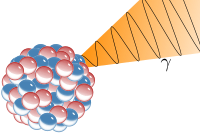
Photo from wikipedia
Background The proton therapy is a form of particle radiation therapy that dose enhancement to improve therapeutic ratio (TR) is obtained by high-Z materials. This study evaluated the physical properties… Click to show full abstract
Background The proton therapy is a form of particle radiation therapy that dose enhancement to improve therapeutic ratio (TR) is obtained by high-Z materials. This study evaluated the physical properties of dose enhancement and the resulting changes in the secondary particle production using the spread-out Bragg peak (SOBP). Methods Monte Carlo simulations were performed using the Geant4 software and the medical internal radiation dose head phantom. Gold and gadolinium were applied as enhancement materials at concentrations of 10, 20, and 30 mg/g in the tumor volume, and the composition of soft tissue was varied in parallel. The ratio of changes in the reaction caused by the interaction of the initial particles with the enhancement materials was calculated. Results Among the physical interaction processes, inelastic Coulomb scattering by electrical action occurred with the highest frequency of 99.02%, and elastic collisions, nuclear inelastic collisions, and multiple Coulomb scatterings appeared with low frequencies of 0.633%, 0.334%, and 0.006%, respectively. The use of gold as the enhancement material increased the frequency of interactions by a factor of 1.14–1.18 for inelastic Coulomb scattering, 1.05–1.30 for elastic collision, and 1.03–1.37 for nuclear inelastic collision. Furthermore, the use of gadolinium as the enhancement material increased the frequency of interactions by a factor of 1.08–1.14 for inelastic Coulomb scattering, 1.03–1.25 for elastic collision, and 1.01–1.34 for nuclear inelastic collision. Regarding the dose by the production of secondary particles, the equivalent dose increased by a factor of 1.032–1.070 for alpha particles, 1.133–1.860 for neutrons, and 1.030–1.053 for deuterons when gold was used as the enhancement material. When gadolinium was used as the enhancement material, the equivalent dose increased by a factor of 1.015–1.043 for alpha particles, 1.075–1.478 for neutrons, and 1.021–1.036 for deuterons. Conclusions Based on this study’s findings, the dose enhancement simulations correspond to the physical characteristics of energy transmission. The study’s results can be used as basic data for in vivo and in vitro experiments investigating the effects of dose enhancement.
Journal Title: Translational Cancer Research
Year Published: 2019
Link to full text (if available)
Share on Social Media: Sign Up to like & get
recommendations!